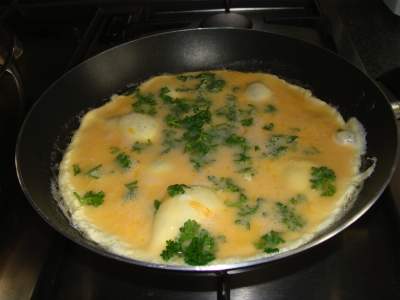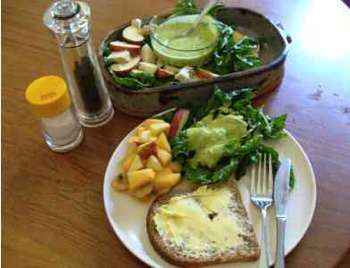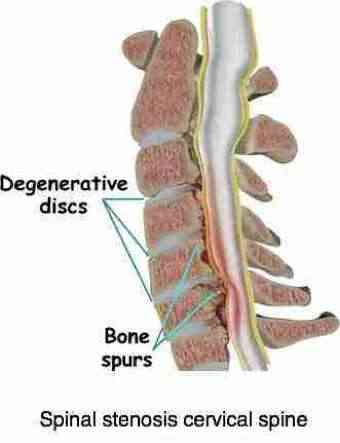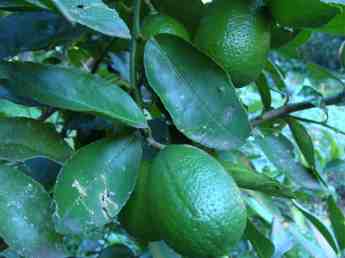- Bernard Preston homepage
- Herbs Spices
- Nutritional Value of Parsley
Nutritional value of parsley
The nutritional value of parsley includes properties that make it a leader in the race to prevent malignant tumours; this rich source of vitamin K helps prevent bruising and osteoporosis.
It is decidedly difficult persuading folk to actually eat the garnish on their plates, despite its subtle flavour and incredible nutritional-value.
So we look for more subtle ways of enjoying our herb; like sprinkling it on scrambled-eggs.

- Firstly because it is very high in magnesium, one of the minerals associated with chronic arthritis.
- Secondly because it is unbelievably rich in vitamin K, a deficiency of which causes easy bruising and weak bones; an incredible 1640 micrograms per 100g. One and a half tablespoons contains your required daily-allowance.
- The vitamins C and A are both powerful antioxidants; hence the protection against tumours.
- It is the folate and vitamin B6, both necessary for the breakdown of homocysteine, that make me so excited about this garnish; that is the amino-acid that causes arteriosclerosis and heart disease. Parsley is good stuff; if you eat it.
- You do not eat parsley for carbohydrate, protein and fats but it is incredibly rich in fibre, minerals and vitamins; and vital phytosterols like flavonoids too.
This page was last updated by Bernard Preston on 7th January, 2023.
Nutritional value of parsley
Nutritional value of parsley confirms it is much more than a garnish. Perhaps it is the presence of magnesium, folate and B6, all essential for the breakdown of toxic homocysteine that make this such an important herb; and in scrambled eggs it is divine.
A parsley pesto will liven up any green salad that you think might otherwise be rather boring.

We are not vegetarians by the way but eat a lot of salads to counter the effect of cholesterol and homocysteine; and to get all those phytonutrients.
Homocysteine is thought to stimulate the release of excitatory amino acids like glutamate and aspartate leading to stroke[2]. In the absence of these important minerals and vitamins it cannot be broken down which should happen immediately it is formed.
"It is a garnish, for heaven's sake, what on earth do you want to eat it for?"
What are phytosterols?
What are phytosterols is an important question for us all to grasp; they make the difference between reaching a happy, vibrant eighty and falling short at fifty.
They are plant fats found in abundance in all your salads and fruits; and particularly flax and sesame seeds. What is interesting is that they have almost the same structure as cholesterol and compete with that from butter, for example for absorption into the blood stream.
If you refuse to sample foods rich in them, then you almost certainly will be taking statins with all their nasty side effects if you are overly-fond of red meat and dairy products; but you can have your cake and eat it after all.
How to "get off statins" safely is a very important page. Use the site search function in the main menu above.
Research done by Ferreira and Goncalves[1] found that the nutritional value of parsley includes 79mg of three important phytosterols in 100g.
- B-sitosterol
- Stigmasterol
- Campesterol.
| PARSLEY | BROCCOLI | COS LETTUCE | RADISH | |
| Fibre | 3,3 | 2,6 | 2,1 | 1,6 |
| Calcium | 138 | 47 | 33 | 25 |
| Magnesium | 50 | 21 | 14 | 10 |
| Potassium | 554 | 316 | 247 | 233 |
| Zinc | 1,1 | 0,4 | 0,2 | 0,3 |
| Vit C(mg) | 133 | 89 | 24 | 15 |
| Folate (mcg) | 152 | 63 | 136 | 25 |
| Vit B6(mg) | 0,1 | 0,18 | 0,07 | 0,07 |
| Vit A(IU) | 8424 | 623 | 8710 | 7 |
| Vit K(mcg) | 1640 | 101 | 102 | 1,3 |
Nutritional value of parsley sauce
So I have found a way to cheat. Make a parsley-sauce by adding it to your salad dressing, whir it up with the blender; suddenly all the greens on the table are eaten with relish. And whilst you are stacking the dishwasher, your guest will whisper in your ear, what a delicious condiment it was.
What's in it? Why parsley, of course is the main ingredient.
- A handful of parsley
- Half a lemon, get the pips out but include all the pulp
- Half an orange
- Olive-oil
- Avocado
- garlic
- Raw honey
- S&P
Just use a stick blender.
Avoid polyunsaturated oils especially those from seeds, rich in omega-6 for your salad dressings. Why is that?
This page on foods to reduce inflammation reminds us to stick to extra-virgin olive oil. Add that to the nutritional value of parsley and avocado; you have a winner.
This is a controversial subject; the scientists are still arguing the toss. We do need polyunsaturated oils, just not too much; but look for the cold-pressed.
Tabouli
Tabouli is a great Lebanese dish; you can make it in only ten-minutes. It is loaded with the nutritional value of parsley and mint. Make sure you have them fresh from the garden; they are so easy to grow.
Authentic Hummus Recipe
Any authentic hummus recipe will make a dull salad light up.
One of the main benefits of hummus is the nutritional value of parsley. Made from chickpeas and sesame seeds it is the perfect side-dish to go with any salad. Rich in phytosterols, the vitamins to prevent a homocysteine buildup and vegetable protein, it's a fundamental Mediterranean dish.
Once you have got the ingredients together, it takes only five minutes to rustle up this authentic hummus recipe.
Chronic arthritis
Chronic arthritis is really not something you have to suffer from; but you will have to ring in the update before it is too late. The magnesium in the nutritional value of parsley is one of the magic ingredients when it comes to degenerative change in joints and heart disease.
More generally consider the magnesium in dark-green leafy vegetables like spinach.
Keeping toxic levels of homocysteine in the blood down is essential in the fight against arthritis and many other chronic diseases. As a garnish it is the least of parsley's many virtues; it is the queen of folate and rich in vitamin B6 too.
Nutritional value of parsley and spinach.

There is an epidemic of joint deterioration in our Western society. Doctors are thriving but there are so many simple things you can do that will make such a enormous difference to the pain and worse, disability, you may be feeling in your spine; the nutritional value of parsley is just one of them.
Obesity and Arthritis
The "Banting diet" is low in starch but high in fat; it's for those suffering from obesity and arthritis in knees and feet. Hypertension and type-2 diabetes come into the equation too obviously. Type it into the Site Search tab above for more information.
I am not going to badger you but do understand that if you are obese, pain and pills are going to be your constant companions. Get that weight off, or suffer. And the best way is to seriously limit the refined carbohydrate in your diet. Daily greens like parsley are part of the solution; they contribute large amounts of magnesium and potassium to improve circulation and lower blood pressure.
Banting is raising considerable interest but remains controversial. Certainly the typical Western diet of very high refined carbohydrate has been the underlying cause of obesity in the world; all low fat fads make us ravenous and so are doomed to fail.
It is the high glycemic index carbohydrate that makes us fat; white rice, cakes and cookies. Colas, sodas and sadly potatoes are more examples unless you can find new spuds that have more resistant starch.
The typical American now consumes half a cup of sugar every day, much of it in energy drinks and colas; that is the chief cause of obesity.
Find out more about resistant starch if you have a weight problem.
Could a high fat plan make you thin? That is the tantalizing thought from the ketogenic diets.
In that lunch above there is some starch in the bread, the fruit and the honey but mostly it is a high fibre meal. Just as important is that all the carbohydrates have a low glycemic index; there is no insulin surge from this type of food.
The slips of parsley are more for flavour, but they do help
lower the GI. For more direction, follow our "free weight loss programs."
You will find them using the search function in the navigation bar. The longevity diet uses these principles; for those who desire to live long in the land and reach a sprightly eighty or ninety.
Chondrocalcinosis
A group of scientists scanned the literature and found that a magnesium deficiency is the underlying cause of an arthritic condition called chondrocalcinosis; the nutritional value of parsley includes a large amount of the mineral.
What is more, this condition exists in 10 percent of Western sixty year-old folk. No wonder we are a society ridden with arthritis.
Chondrocalcinosis causes these offending crystals to deposit in the cartilage causing chronic arthritis. Spinach is the richest source of magnesium, closely followed by parsley. Do you want to be free of pain and strong like Popeye?
Growing greens is for every family with a just a tiny garden; you really could and should have a spinach patch. Enjoy the baby leaves fresh in a salad too.
Omega-3 and arthritis
Omega-3 deficiency and arthritis are closely correlated too; add that to the parsley.
There is heaps of research now proving that those who eat a diet rich in fish have much less degenerative change. Omega-3 fatty acids reduce the general inflammation in the body that is at the centre of chronic arthritis, heart disease and even conditions like Multiple Sclerosis.
The heart foundations recommend fatty fish at least twice week; if you suffer from chronic arthritis I would at least double that. Add freshly-ground flaxseed to your food as well.
An excellent vegetable source of omega 3 is freshly-ground flax. Whir a tablespoon of the seeds daily in an inexpensive coffee grinder and add it to your cereal; or together with nuts in a smoothie.
Magnesium from nuts and seeds is central to greater well-being.
There is no omega-3 in the nutritional value of parsley but this just rounds off a page on chronic arthritis; a good diet should include fatty fish and various green herbs.
Vitamin C in parsley and arthritis
Research done on a sample of 20,000 people found that those who ate foods rich in vitamin C were 3x less likely to get polyarthritis, compared to those who ate the least; it is essential for the healing of connective tissue after injury[3].
Just 10g of parsley has the same amount of
vitamin C as 100ml of OJ in a carton. Freshly-squeezed orange juice has three
times as much; you only need about 30ml.

Fruit like citrus and peppers that are rich in vitamin C are also essential for preventing the premature onset of frailty.
WHIPLASH and ARTHRITIS
If you have
arthritis in your cervical spine your doctor is likely to ask,
not if you have had a whiplash, but when the accident happened.
Occasionally, he or she may be wrong but nine times of ten they will be spot on target.
And if you are on a black and white diet, devoid of the dark-green leafy vegetables like parsley, then you can be certain there are troubles to come.
Cumulative effect
Of course all these
effects are additive. Do you eat little or no fatty fish, abhor fruit
and salads and have a short leg? Are carrying too many pounds, and
have had a whiplash injury? Chronic arthritis and pain mostly likely await you.
"The more serious the illness, the more important it is for you to fight back, mobilizing all your resources; spiritual, emotional and intellectual. Physical matters too will contribute."
Norman Cousins
Parsley Benefits
- Why flavonoids in the Mediterranean diet, despite being high in saturated fat, give protection from heart disease?
Another benefit of parsley is the flavonoids that give it a dark green colour. They provide fruit and salads with their antioxidant properties, helping to prevent tumours and allergic reactions.
In a review of the literature, Nijveldt et al from the Department of Surgery at the VU in Amsterdam, report on the amazing antioxidant properties of flavonoids.
During normal metabolism,
the free radicals and reactive oxygen species produced, if not mopped
up, cause lipid peroxidation of the fatty membranes leading to
swelling and cell death. If you have a bit of a chemistry background, you will find this a fascinating
study; otherwise just read the abstract. It is all in the green organic food.
Chimichurri sauce
Chimichurri sauce is a good way to preserve parsley; freeze it in an ice-tray and pop the blocks into a bag.
For more about these nutrients and others in plants that we eat, go to our authentic hummus recipe page, scrolling down until you come to more details about flavonoids; include them in your diet, or suffer.
The rule of thumb is a minimum of five coloured foods per day, and I always aim for ten. This morning for breakfast I have already had my five. I started with yellow maizemeal porridge, a fruit salad with mulberries and sweet melon; and scrambled egg with parsley on toast. My salad at lunch will include at least another half dozen.
Truth be told,
I have a lot of metastatic disease in my family. I am pretty scared of it, even
if much of it is smoking related, so perhaps I go overboard. But then
you probably too have a lot of deaths from tumours around you; we all do.
Here is a little tip; sometimes the thought of a whole apple just does not appeal. Then just have a half; or a quarter. Just start every day adding more coloured food to your diet.
Tomato prostate is essential reading for every man, and his wife too; are you not both afraid of impotence?
Type "tomato prostate" into the Site Search tab in the main menu above.
Apigenin
Apigenin is a flavonoid found most richly in parsley and celery. There is a heap of evidence showing that it inhibits COX-2 and stimulates regeneration of nerves. The trick is to include these herbs and coloured vegetables daily in our diet to prevent catastrophic disease; not to try and cure it after the event.
"Let thy food be thy medicine."
Hippocrates, father of medicine (460 - 370 BC)
Apigenin is also one of the substances that is highly recommended as food for the brain. Its neurogenic properties help prevent senility.
Freezing Parsley
Obviously your parsley does not grow year round. You may be able to purchase fresh but freezing it for your soups and stews is dead-easy.
Take your fresh fronds of parsley; cut deep down near the heart of the plant. Wash them thoroughly, shake vaguely dry and place them in a see-through plastic bag; pop in the freezer. What could be easier?
I would still use fresh herbs for your salads and dressings if you can get them. Frankly, I am not sure whether the nutritional value of parsley is affected by freezing. I think not but straight from the garden is always better.
USEFUL LINKS
When browsing use right click and "Open Link in New Tab" or you may get a bad gateway signal.
Newsletter
Our newsletter is entitled "create a cyan zone" at your home, preserving both yourself and Mother Earth for future generations; and your family too, of course. We promise not to spam you with daily emails promoting various products. You may get an occasional nudge to buy one of my books.
Here are the back issues.
- Investing in long-term health
- Diseases from plastic exposure
- Intensive lifestyle management for obesity has limited value
- A world largely devoid of Parkinson's Disease
- The impact of friendly bacteria in the tum on the prevention of cancer
- There's a hole in the bucket
- Everyone is talking about weight loss drugs
- Pull the sweet tooth
- If you suffer from heartburn plant a susu
- Refined maize meal and stunting
- Should agriculture and industry get priority for water and electricity?
- Nature is calling
- Mill your own flour
- Bake your own sourdough bread
- Microplastics from our water
- Alternative types of water storage
- Wear your clothes out
- Comfort foods
- Create a bee-friendly environment
- Go to bed slightly hungry
- Keep bees
- Blue zone folk are religious
- Reduce plastic waste
- Family is important
- What can go in compost?
- Grow broad beans for longevity
- Harvest and store sunshine
- Blue zone exercise
- Harvest and store your rainwater
- Create a cyan zone at your home
Did you find this page interesting? How about forwarding it to a friend, or book and food junkie? Better still, a social mead tick would help.
- Bernard Preston homepage
- Herbs Spices
- Nutritional Value of Parsley
Address:
56 Groenekloof Rd,
Hilton, KZN
South Africa
Website:
https://www.bernard-preston.com